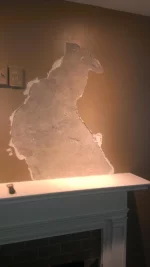Hello everyone--I am brand new here & brand new to plaster work, and I have a big question for you all:
My husband & I bought a house that is about 80 years old last year. Most of the walls are plaster. About 6 months ago, due to a roof leak, the wall above the living room fireplace got water-damaged, and it bubbled up pretty badly. I have finally gotten around to *trying* to fix it, and I was given this advice: Tap & scrape the bubbled & loose plaster off. Remove as much of the dust as possible. Paint the area with KILZ primer to create a moisture barrier. Let dry. Apply Plaster of Paris. Dry & sand. Apply joint compound. Dry & sand. Paint. Done!
Well, as usually happens when I do any project, there was a surprise. Under the plaster is a very hard cement-like surface. I have attached 2 photos--I hope you can see them clearly. I had a close-up of the cement surface, but I could not get it to upload for whatever reason. There are tiny pebbles visible in it, and it is grey in color.
I think I have all of the loose & damaged plaster removed. We brushed and vacuumed as much dust off as possible. After doing this, I did an internet search to try to find out what the cement-like surface is and if I should omit the KILZ step. That is when I learned of asbestos cement millboard, and it has me a little freaked out, because we had plaster dust flying all over the place!
Can any of you tell by the photos what that surface is? If you think it is asbestos, what should I do??? If not, a big WHEW! --And then, should I skip the KILZ?
Thanks very much for your help.
~Clueless in Kentucky :huh:
My husband & I bought a house that is about 80 years old last year. Most of the walls are plaster. About 6 months ago, due to a roof leak, the wall above the living room fireplace got water-damaged, and it bubbled up pretty badly. I have finally gotten around to *trying* to fix it, and I was given this advice: Tap & scrape the bubbled & loose plaster off. Remove as much of the dust as possible. Paint the area with KILZ primer to create a moisture barrier. Let dry. Apply Plaster of Paris. Dry & sand. Apply joint compound. Dry & sand. Paint. Done!
Well, as usually happens when I do any project, there was a surprise. Under the plaster is a very hard cement-like surface. I have attached 2 photos--I hope you can see them clearly. I had a close-up of the cement surface, but I could not get it to upload for whatever reason. There are tiny pebbles visible in it, and it is grey in color.
I think I have all of the loose & damaged plaster removed. We brushed and vacuumed as much dust off as possible. After doing this, I did an internet search to try to find out what the cement-like surface is and if I should omit the KILZ step. That is when I learned of asbestos cement millboard, and it has me a little freaked out, because we had plaster dust flying all over the place!
Can any of you tell by the photos what that surface is? If you think it is asbestos, what should I do??? If not, a big WHEW! --And then, should I skip the KILZ?
Thanks very much for your help.
~Clueless in Kentucky :huh:



